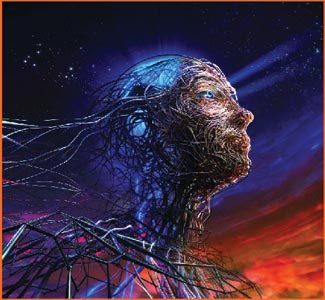
At SIGGRAPH, the annual coming out party for animation software, all the majors announced new releases, and most are focused on one thing - harnessing the power of the gaming industry's next-generation consoles. This, of course, will have positive ripple effects for other 3D applications.
"It used to be that game character animation was nowhere near as sophisticated as film," says Autodesk product marketing manager Dan Prochazka. "Now, in many 3D applications, games are at the cutting edge of technology more so than films because the new processors and the next-generation platforms are unbelievably powerful. They can handle much more complexity,"
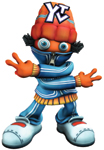
Softimage user Buzz Image Group in Montreal created Stretch for YTV.
|
Alias Maya customers clamored so loudly for beefier tools that the company gave them V.6.5 in January, a performance release, followed by this month's V.7, a feature release. "We're at a tipping point now where we're all at the process of building up our production pipelines for these next-gen consoles," says Rob Hoffmann, Alias's senior product marketing manager for entertainment. "Version 6.5 worked on the challenge that many of the artists and facilities were running into - the need to handle greater amounts of data. With PS3 and the next-generation consoles coming out... the problem that plagued every package out there was the ability to elegantly manage and manipulate large amounts of data, and that's what we were really focused on. Make it so it's going to plug into the pipeline, make it so it's able to handle massive amounts of data. That also applied over to the film and broadcast side of things. [Films] are coming up with more elaborate special effects, whether it be main characters like in Star Wars: Episode 3, where Yoda was created using Maya, or a film creating many of the background sets so they don't have to construct these things and they can shoot much of the action on bluescreen."
Adds Gareth Morgan, Softimage|XSI senior product manager, "In terms of scalability, we're starting to see that the games industry is driving the high end of the scale with these very large animation teams. One of our key concerns, with the next-generation game consoles and looking at potentially 10 times the level of detail and complexity of art, is focusing on really making sure the software adapts and anticipates those huge increases in complexity and productivity."
The power brings with it new processes, and the software makers are looking hard at how to make their new technical tricks easy to use.
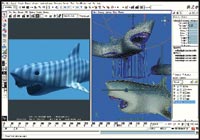
Maya 7 offers simple scene setup with render layers. Users can now separate scene elements into manageable pieces that can be fed downstream to compositors without the need to manage numerous scene files.
|
"The challenge is about investing in finding an intuitive artistic paradigm to harness the power of these systems they're working with," says Morgan. "Once we're getting into these very rich and sophisticated kinds of art production, it gets very technical and complex. You have this whole industry of render wranglers and technical directors and people who are extremely technically skilled in supporting artists. One of the things we've always tried to do, and we're really invested in for V.5, is accessibility and ease of use, really trying to streamline the product. We're in a high technology space with these products and the tendency is to sort of use the latest research and bundle it into something that sort of works and try and offer that to customers. That often leaves a lot of technical problems for customers to solve."
What follows is a roundup of the latest 3D animation software releases with their highlights. Please note that most of the projects cited were created in versions prior to the ones just released.
ALIAS MAYA 7
PLATFORM: Windows, Mac OS X, Linux
PRICE: Complete: $1,999, Unlimited: $6,999
USERS: Film, game, digital publishing, Web design, broadcast
SIGGRAPH NEWS: Integrated Motion Builder technology. Alias bought Kaydara last SIGGRAPH so Maya now has a full body IK system that allows artists to rig and post characters much faster and easier, and it enables natural articulation of biped and quadruped models.

3DS Max 8 includes Pelt Mapping (left), which allows artists to quickly unwrap the UV coordinates of geometry using custom-placed seams. New Relax methods remove distortion for stretch-free mapping. Animation clips can now be loaded into the Motion Mixer (right) and can provide nonlinear animation editing for any 3DS Max rig.
|
New toon shader. It's very powerful, giving the artist the ability to create a wide range of non-photorealistic rendering styles like different types of Japanese anime. "One of the really cool things about it is the control the artists have over the line draw and the fill is really second to none," says Hoffman. "They can really achieve a true 2D cel hand-drawn look or they can go for something radically stylized." It features interactive previews in near realtime.
Upgraded modeling system. They've added numerous new polygonal modeling and UV mapping tools. "We've created one of the best and well rounded comprehensive modeling systems within a 3D package that is currently available. It's all about enhancing the modeling productivity," says Hoffmann.
Re-architected render layers technology allows multiple passes - from any combination of Maya software's four renderers - be prepared for optimal output to any compositor. Layers can also be rendered to Photoshop and Flash files.
PROJECTS: Feature films: Madagascar (Disney), War of the Worlds (ILM), Charlie and the Chocolate Factory (Motion Picture Company), Star Wars: Episode 3 (ILM),Stealth (Digital Domain), King Kong (Weta). Games: Grand Theft Auto/San Andreas (Rockstar Games), Doom 3 (Activision).
AUTODESK 3DS MAX 8 release: october 2005
PLATFORM: Windows
PRICE: $3,495 (Character Studio is no longer stand-alone; its components are now Max features.)
USERS: Design/visualization market, games, broadcast/film

Zoic Studios used NewTek LightWave V.8.3 on the feature film Serenity. LightWave 9 was new at SIGGRAPH and will be available in Q4.
|
SIGGRAPH NEWS: "I tend to think of releases not as individual features but as sets of features that complement something that we were trying to do. For me, there are four things I was trying to get done in this release," says Prochazka. See below.
Asset management: "This is something that is an Autodesk-wide thing - one, we follow their mandates but, two, we're also funded to do it - an asset management system that's very rich, very deep, very accessible and basically free on the clients' side," he says. "We now support Autodesk Vault." An additional layer also allows different asset management systems to be used easily within Max. "The same things we were seeing in Autodesk's more traditional markets [ie. construction, architecture] are very much affecting our markets. They're one large company but they have many, many offices spread out all over."
Process of defining/editing/painting on UVs: "I believe we're the first ones out the door with a real true and proper Pelting System," reports Prochazka. "Combined with the new UV tools that we've added, what once took a day to do a character, they can do it in an hour. It is a huge leap forward in the process of defining UVs and getting them accurate and basically getting rid of the issues around texture stretching that you see on characters. This is a big deal in games and also in the visual effects/entertainment industry. One of the big problems with trying to define UV coordinates is frequently the texture space is different than the geometry space... trying to get that all balanced out is a real hassle. That's the thing that can take eight to 10 hours a character and now we can eliminate that effort with a little bit of setup, push a few buttons and off you go."
Character animation: "This is why I think this release will be a pretty big deal for film," says Prochazka. "The character requirements for games and visual effects have pretty much come to the same place. We've always had the Biped Primitive, and in many ways that was the most advanced set of tools of any 3D character animation system. The reason why it doesn't frequently get used in a lot of higher end instances is if you want to do what the Biped Primitive does, it was great. But if you got outside what it really did well, it didn't do it at all. We took those concepts, like being able to take the motion from one character and apply it to another character even if they were radically different size scale. A classic example is taking motion out of a biped and doing it on a non-character primitive, a rig they built themselves. We allowed these biped [motions] to be done arbitrarily. We now support arbitrary rigs. That's huge - Softimage has introduced it but Alias's isn't quite up to par [just yet]."
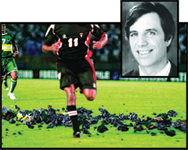
Digital Domain used a beta version of Houdini 8's new Rigid Body Dynamic Solver on this Gatorade Shattered spot. Side Effects' Kim Davidson is inset.
|
Max script debugger: "We are the first to introduce a debugger to a scripting language for a 3D application," he continues. "Scripting languages were really designed to handle small little scripts, but they're so powerful that their reach exceeds their grasp. When there's a problem with them there's no way to figure it out other than line by line, as opposed to doing it in a code where you'd have a debugger, where you can put in breaks, where you can check for syntax errors. Basically it allows people to narrow down and identify the problems in their Max scripts. It's a huge timesaver."
PROJECTS: 3D break-away scenes in Lost TV series (Digital Dimension).
NEWTEK LIGHTWAVE 9.0 Release: Q4 2005
PLATFORM: Windows, Mac OS X
PRICE: $795
USERS: Film, broadcast graphics, games, education and hobbyist markets
SIGGRAPH NEWS: "This year we've tried something different with the LightWave 8 cycle, we've come up with a major release every few months," says Jay Roth, president, 3D division. "The idea is to have a good pace of bug fixes, and if we have a technology that's ready to see the light of day, then more than likely we're going to release it. That's been the philosophy, and it's actually been working out very well for us.
"A lot of people were wondering, 'What's next for LightWave? You've got a whole new crew in there.' So, we decided to show the world Version 9.0 at SIGGRAPH, showing we're very capable of coming out with new features and fixing existing issues. We're looking at workflows and performance.Version 9.0 will have an impact on user interaction with almost every level of the product."
Rebuilt OpenGL engine: "We're supporting vertex and pixel shaders now, and tying that into our materials library," reports Roth. "So, it's a fairly accurate preview. There are still limits to OpenGL, of course, compared to what you get when you hit the render button."
Ability to handle larger data sets more quickly: "Obviously, we're going to assume that modern OpenGL cards are in use here, but it's our philosophy that today's high end OpenGL card will be tomorrow's gaming card for $100, so we feel very confident making certain assumptions about performance."
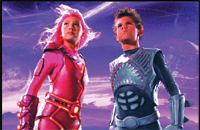
Robert Rodriguez's Troublemaker Studios in Austin employed Softimage|XSI on Shark Boy and Lava Girl in 3D.
|
Speedier dynamic simulations: "One of our production partners had a scene that took 20 minutes to load based on some exploding spaceship material, and we got that down to 20 seconds. So, we're really concentrating on throughput and getting under the hood and saying, 'It's been a while since this may have been looked at, let's go in and see what we can do with today's point of view.'"
Roth adds, "There is the class of user in the production community that doesn't want you to get in their way - 'Don't do things that are going to slow me down.' So we try to keep that in mind, but at the same time we look at the basic workflows and 'Does it really slow somebody down if we take a feature with 13 mouse clicks and make it two?' There's some pretty obvious wins when you're looking at workflows and ease of use, but there are other things that people like that we won't touch. It's called communication. We're trying to improve the communication with our production partners. We've started little pilot projects along those lines, and we're working to expand those as we go."
PROJECTS: Feature film Serenity (Universal)
SIDE EFFECTS HOUDINI V.8
PLATFORM: Windows, Linux
PRICE: Starting at $1,299
USERS: Eighty percent film, 20 percent game and commercial
SIGGRAPH NEWS: Rigid Body Dynamic Solver: Digital Domain used this system for its latest Gatorade spot that has three people falling into little bits. Instead of animating smashing, breaking things, the workflow simulation handles it by plugging in a number of pieces, their weight and how they're glued together. It now also allows solvers to "work within the package and to talk to each other so you can have a rigid body talking to a cloth solver. That's typically not been done before," says Side Effects president/CEO Kim Davidson. For example, a rock could hit a cloth and both elements would interact in the physically proper way. Previously, users had to run the rock solver and hand animate the cloth at that connection. This also eliminates the need for animators to write their own solvers outside the package (like water, cloth or hair), let them run separately and then integrate them into Houdini. In addition to that architecture, there are two solvers: Rigid Body with Glue Constraints and Cloth with Panel Stitching, but they can still plug in their own solvers.
Interactive Photorealistic Rendering (IPR): This supports Houdini's own renderer, Mantra, as well as Pixar's RenderMan. "Lighting in our package or all packages is fairly labor intensive and you wait a long time to see all the shadow maps, all the effects of the lights, the effects of the shaders, and this allows very quick lighting iterations," says Davidson.
Most functionality upgrades come directly from their customers. "A lot of dynamics were driven through our alpha program with Digital Domain. The character improvements were driven with our work with Core Digital Production on the Disney feature The Wild. We're working with DNA in Texas [who worked on Jimmy Neutron] on a new movie called The Ant Bully [DNA Productions and Warner Bros.]. They're asking for lots of lighting improvements, deep shadow maps and lots of asset management tools, like 'I want to flag my objects this way.' We were the customers 17 years ago; 80 to 90 percent of our company is working and talking with customers. We're pretty customer-centric," he says.
PROJECTS: Gatorade Shattered spot (Digital Domain), feature film The Wild (Disney)
SOFTIMAGE|XSI 5
(32-bit and 64-bit)
PLATFORM: Windows (including Windows XP 64), Linux
PRICE: Foundation: $495, Essentials: $1,995, Advanced: $6,995
USERS: Games, film effects
SIGGRAPH NEWS: Sixty-four-bit: "There are three key areas where making a native 64-bit version really makes a difference," explains Gareth Morgan. "Performance: the limits of the system are obviously much higher. Precision: 64-bit can handle much more precision in fewer clock cycles. Memory: they can address an enormous amount of memory space. Another area where we've invested a lot is in the core architecture of XSI, to make sure it can really efficiently manage very complex data sets, make the best use of the memory and the hard disk subsystem that's available."
Richer, more complex shader technology: "Along with the next-generation consoles, and the very fast, powerful hardware-accelerated graphics pipelines the systems are now going to have, you need authoring tools and also ways for creative people to get the most out of those technologies. Over the years we've pioneered realtime shaders inside XSI; it's a way to associate these rich rendering pipelines with models and characters," says Morgan.
PROJECTS: Films: Shark Boy and Lava Girl in 3D (Dimension Films) Fantastic Four (20th Century Fox), Sin City (Dimension Films). Games: Half Life 2 (Valve), Metal Gear (Konami).